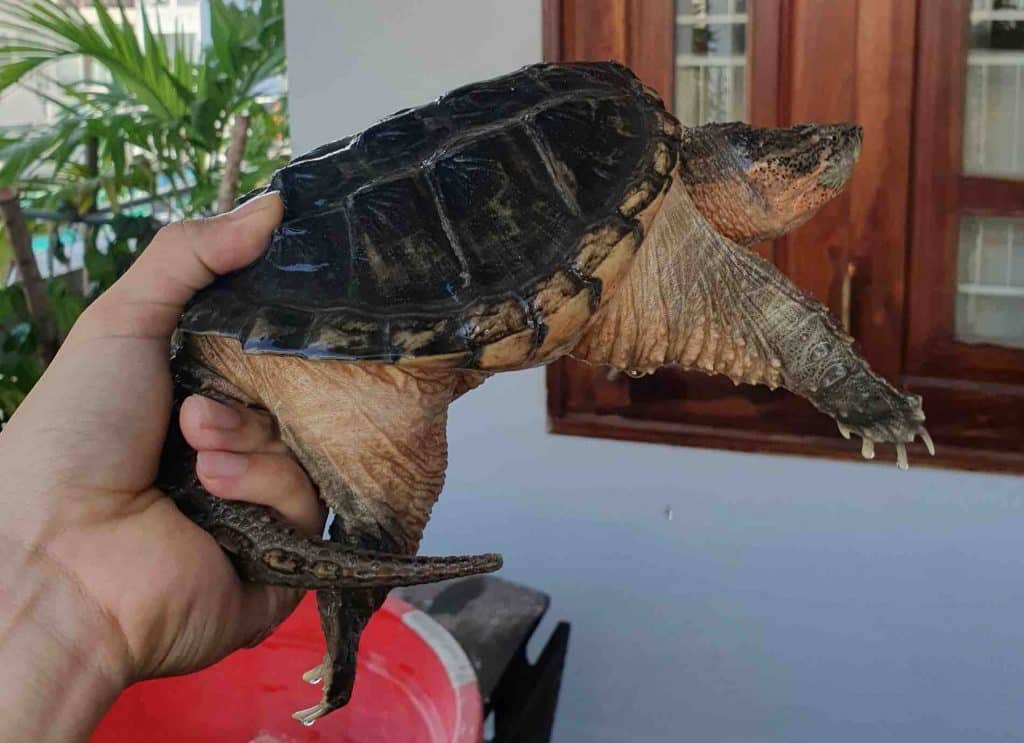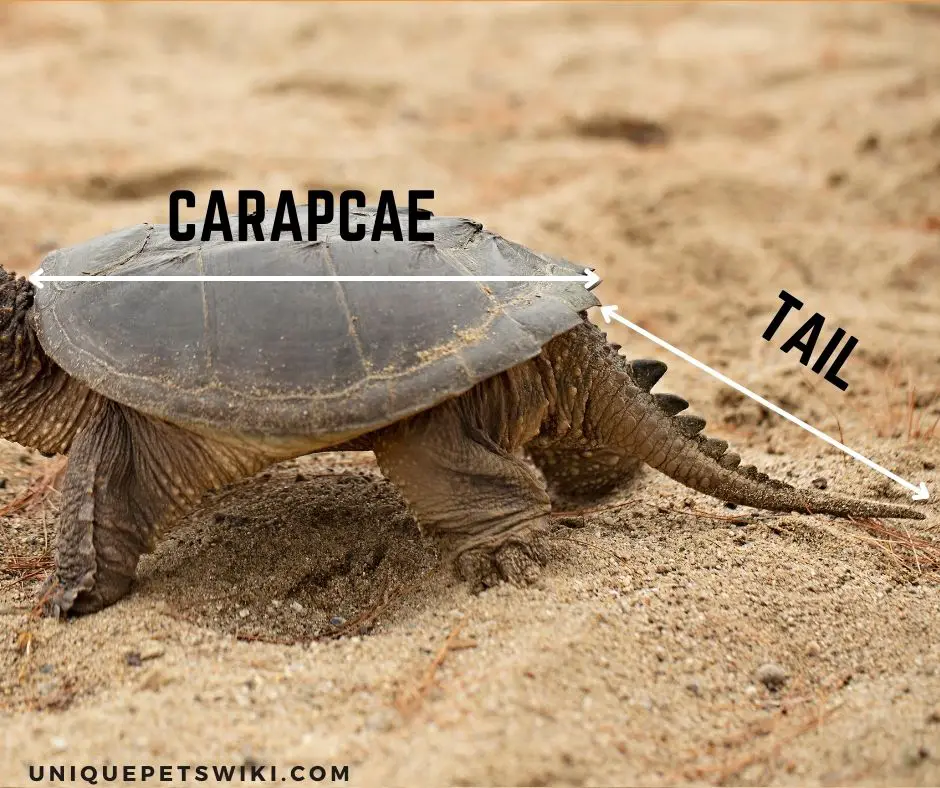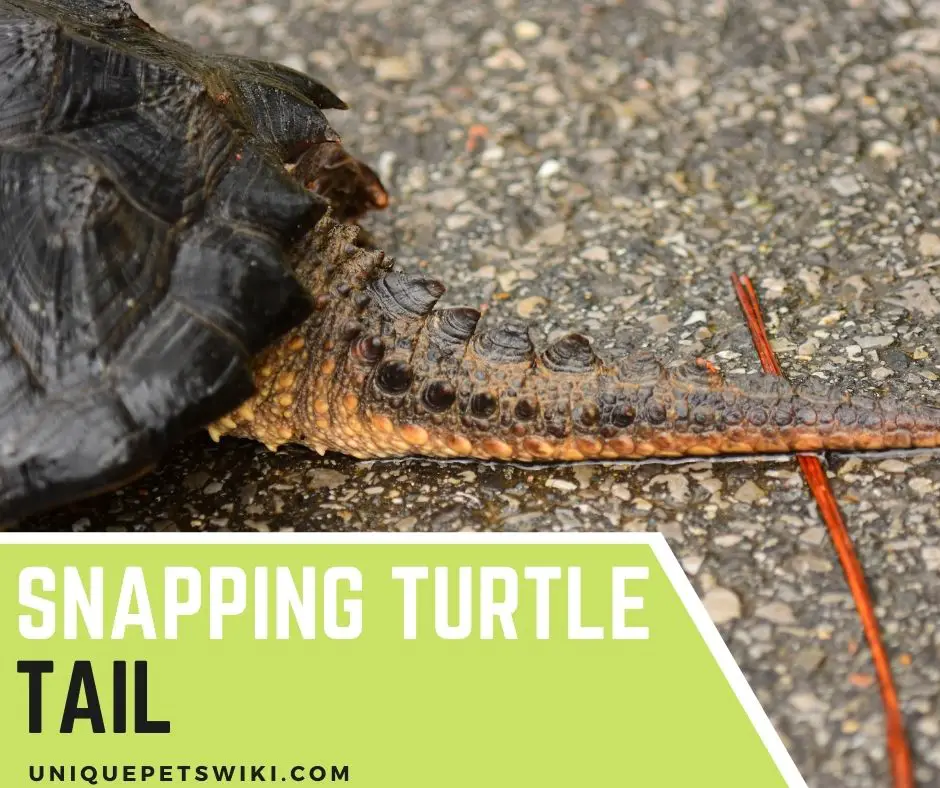Snapping turtles are just one species of turtles with extremely long tails. You may wonder since these animals can bite with a strong bite force, is it safe to hold them by their tails where their beak may not reach? The snapping turtle tail isn’t long such that keepers can handle them by just holding their tails.
Their tails serve more important purposes for their survival. Besides using their tails to tell the sex of an individual snapper, their tails are where their reproductive systems are located, also used as a protective covering for their reproductive system. Through their reproductive opening, they do pass out waste.
This means that if you hold these animals by their tails and the animal sustains an injury from it, it will not just damage lots of things but may lead to the death of the animal.
On this note, we design this article to help you understand the snapping turtle tail better. What it does, its purpose to the wellbeing of the animal, and most importantly, how to appropriately handle your pet.
Read on to learn more!
This article has been reviewed by Dr. Gospel. Read more about our knowledge control process here.
Contents
What Does A Snapping Turtle Tail Look Like?

Snapping turtles (both the common and alligator species) are the only turtle species with extremely long tails. The snapping turtle tail is not only long but has one to three rows of spiked osteoderms on the tail.
The positioning, arrangement, and the number of rows of these osteoderms an individual snapper has differ between the two species and also between sexes.
The alligator snapping turtles have long and thin-looking tails of about the same length with their carapace with spiked osteoderms on it arranged in three rows. Because of the slender nature of alligator snapping turtles’ tails, the bigger they grow, the longer their tails get and the less pronounced (smaller) the osteoderms become.
On the other hand, the tails of common snapping turtles are not as long as the alligator snappers. Rather, the common snappers have fatter/thicker tails. The bigger the common snapping turtles get, the fatter their tails become, and the more pronounced (big and pointed) the osteoderms become.
But for both species of snapping turtles, their tails are thick/big at the base with pronounced spikes.
How Long Is The Tail Of A Snapping Turtle?
The length of a snapping turtle’s tail is equivalent to (the same as) the length of its carapace or even longer. This applies to the two species of snapping turtles – the common and alligator snapping turtles.
Therefore, if your adult snapping turtle is measuring between 8 – 12 inches or more, its tail is about the same 8 – 12 inches long or may even measure longer than 12 inches.

Sex Dimorphism – What’s The Difference Between The Tail Of A Male And A Female Snapping Turtle?
Many species of animals are easily recognized and distinguished between sexes by sexual dimorphism. Sex dimorphism is the difference in appearance between individuals of different sex but in the same species.
For snapping turtles, the most reliable way to determine sex is by looking at or examining their tails. While female snapping turtles have short and thin-looking tails with just one row of serrated ridges called spikes, male snappers have long, thick tails with two rows of spiked ridges.
Moreover, male and female snapping turtles’ reproductive openings (cloaca or vent) are located in their tails. That of the males are positioned closer to the end of the tail, while the females’ vent is closer to the base of the tail.
Should You Catch A Snapping Turtle By Its Tail?
No! Never catch, hold or try moving a snapping turtle by its tail. If you do this, you can injure its spine since its spine runs through its back down to its tail. Besides, the turtle may bite you.
The best way to hold or catch a snapping turtle is to hold it by the back of its shell. But if the turtle is so big that you can’t conveniently hold it this way, try placing one of your hands under its belly but close to the back to provide support.
What Is The Use of Snapping Turtle Tails?
The tail of a snapping turtle is useful for many things. As snapping turtles grow to sexual maturity, breeders can use their tails to tell which is male and which is female.
The tail of male snapping turtles is usually longer and thicker, with two rows of spikes and the vent (penis) is located further from the plastron, much closer to the tip of the tail. Whereas female snapping turtles have shorter and slender tails with just one row of spikes and the vent (cloaca) is located at the base of their tail, much closer to the plastron.
However, using their tails to distinguish between male and female snappers is not the main importance of the snapping turtles’ tails. The tail of a snapping turtle serves two very important purposes:
The first function is anatomical design. This implies that the penis of male turtles is located at the base of their tails. Most of the turtles’ organs are underneath their shells and are not readily accessible, but for mating purposes, the penis of the male turtles has to be more visible and accessible which is why their penis is located at the base of their tails.
Secondly, the cloaca or vent is located in the tail and the tail serves as a protective covering for the vent. A cloaca or vent is a posterior opening for urinary, reproduction, and digestive tracts for reptiles, birds, and amphibians.
Since turtles don’t excrete the familiar urine and feces as mammals, but a combination of urine or urates (usually solid white), and some fecal material (usually slightly runny and may be greenish); their cloaca is where these matters come out at once.
In addition, the vent serves as the vaginal opening for mating in females and the opening through which eggs are laid. In a nutshell, the vent is a very important opening in the female turtles’ tail and the tail is to cover and protect the vent.
NOTE: It’s important to note that turtles don’t use their tails for navigation in the water as many would assume, neither do they use their tails for balance like many terrestrial animals do. Also, as turtles are not arboreal (tree-dwelling) animals, they do not use their tails for hanging or climbing.
FAQs
Do All Turtles Have Tails?
Yes, all turtles, irrespective of the species, have tails. The tails of turtles play very vital roles in their reproduction and survival. Also, their tails become handy for breeders when they want to tell the sex of the turtle.
How Can You Tell If It’s A Snapping Turtle?
Snapping turtles are easily distinguished from other species of turtles that look similar by their small and nearly flat carapace, small plastron, bulky head, large body size, an extremely long and flexible neck of about 19 inches, and a varying shell color of black, tan and dark brown. Snapping turtles are the only turtle species that have serrated ridges on their tails.
Can A Snapping Turtle Bite You If You Hold It By The Tail?
Yes, you can get your fingers bitten off if you hold a snapping turtle by the tail.
Moreover, it’s not appropriate to hold a snapping turtle by its tail because holding it by the tail can cause spinal injury to the turtle.
What Kind Of Turtle Has Spikes On Its Tail?
Not many species of turtles have spikes on their tails. Actually, the only known turtle with spikes on its tail is the snapping turtle. That includes the two species of snapping turtles – the common and alligator snapping turtles.
Wrapping Up
Snapping turtles are one of the most fascinating animals herpetologists love to keep in their homes as pets. Oftentimes, in some regions in Northern America, you’ll see these animals want to cross the road especially during the early summer (that is usually between May – June).
During this period, female snapping turtles usually leave the water searching for a dry, safe place on land to lay their clutch of eggs. While in search, they may need to cross the road to the other side, where they can lay their eggs. And as a concerned animal lover, you may be tempted to hold it or move it by the tail. But is it the right thing to do? Absolutely not!
As we have discussed in this article, snapping turtles’ tails are a very vital part of their body that shouldn’t be handled anyhow because that may cause serious injury to these animals or may even cause their death.
Let’s know in the comment section what myth you heard about the snapping turtles’ tail.
